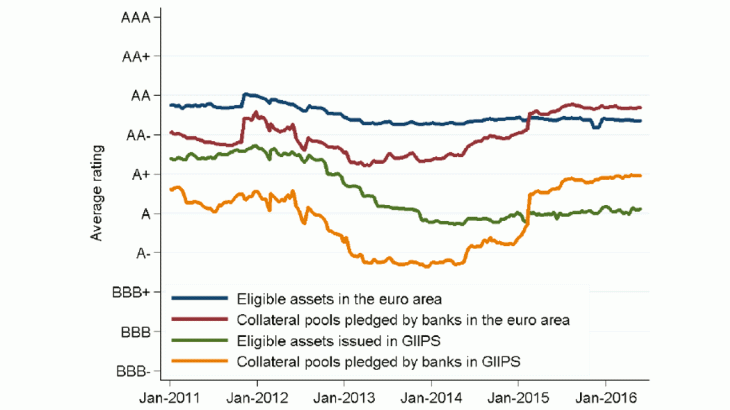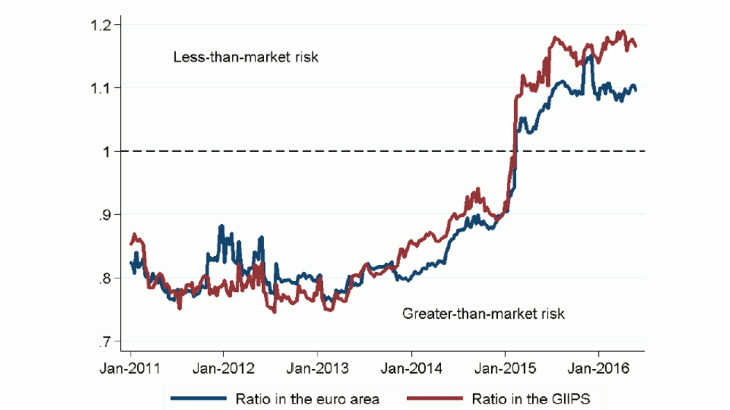- Home
- Publications et statistiques
- Publications
- No excessive risk in the quality of coll...
No excessive risk in the quality of collateral pledged with the Eurosystem during the crisis
Post n°54. Certain critics feel that the Eurosystem took excessive risks to fight the crisis by accepting poor quality collateral for its refinancing operations. Exhaustive analysis of the collateral pledged with the central bank disproves these claims. Their quality followed that of assets available on the market and improved significantly after Quantitative Easing was announced.

Sources: Eurosystem, authors' calculations.
Note: GIIPS refers to Greece, Ireland, Italy, Portugal and Spain. For the purpose of this article, only marketable securities are considered.
Reading: ln January 2011, banks in the euro area pledged assets with an average rating of AA- (red curve), which is one rating below the eligible asset average in the euro area (blue curve).
The measures undertaken by the central banks to combat the crisis led to a substantial increase in the size of their balance sheets. In the euro area, the Eurosystem's balance sheet grew by almost EUR 3 trillion between 2007 and 2018, approximately EUR 1 trillion of which corresponds to additional loans to banks that were secured with pledged assets. As a result, did the central bank take excessive risks in respect to the assets pledged as collateral?
Collateral to protect the Eurosystem
In order to limit the risks taken by the Eurosystem in its monetary policy operations, all loans granted to banks are secured with assets pledged as collateral, which are seized by the Eurosystem in the case of default. For example, following the Lehman Brothers insolvency, the assets that its European subsidiary had pledged as collateral with the Eurosystem allowed the full reimbursement of the amount granted in loans , thereby isolating the Eurosystem from the vicissitudes of the markets.
The central banks' collateral policy thus protects the Eurosystem from the risk of default associated with its lending of the liquidity needed to combat financial crises. The policy is defined on the basis of eligible asset type (such as sovereign or corporate bonds, or structured products) and their maximum level of acceptable risk (or minimum rating). Banks then select the pool of assets that they pledge as collateral in line with these eligibility rules.
The debate on collateral quality
The debate on the risks taken by the banking system and by the central bank due to lender of last resort operations is as old as the central banks themselves.
In response to the crisis, collateral eligibility rules were extended in order to guarantee monetary policy transmission. Certain economists have criticised the permissiveness of these rules, which in their opinion encourages banks to pledge their riskiest eligible assets with the central bank (Nyborg, 2017 and Sinn, 2014). Others suggest that this led to excessive risk-taking by banks as part of their role in financing the economy (Drechsler, Marques-Ibanez and Schnabl, 2016). These analyses are based on the premise that banks always pledge their poorest quality eligible collateral with the Eurosystem.
Conversely, central bankers recommend a broad scope of collateral eligibility to avoid stifling economic recovery (Bindseil, Corsi, Sahel and Visser, 2017 and Tucker, 2014). This recommendation follows the tradition of the editor of The Economist Walter Bagehot (1873), who advocated during crises a policy of unlimited support against good quality collateral in normal times (Bignon, Flandreau and Ugolini, 2012).
From polemics to facts
However, the Eurosystem's critics have failed to prove that banks always pledge their poorest quality collateral with the central bank. We construct a measurement that disproves this assumption, by computing the change in the average risk of assets pledged as collateral with the Eurosystem – assessed on the basis of credit agency ratings – between January 2011 and May 2016.
Chart 1 shows the changes in the average rating of asset pools pledged as collateral by euro area banks in red and by banks in countries that were hit hard by the crisis – Greece, Ireland, Italy, Portugal and Spain (GIIPS) – in yellow. The risk of default associated with these asset pools declines as the average rating climbs closer to AAA. As a comparison, the blue and green curves depict the average ratings of all assets eligible as collateral on the market based on the residency of the issuer.
The quality of assets pledged in the euro area follows the market trend
Between January 2011 and May 2016, the average quality of pledged asset pools varied by one or two rating notches. There is no indication of permanent quality degradation in the series. The ratings of pools pledged by banks in the countries particularly affected by the crisis (GIIPS) and in the euro area returned to their January 2011 average during the winter of 2015.
The average quality of asset pools pledged during the crisis deteriorated by a maximum of two notches in 2013 compared with 2011. Between January 2014 and January 2016, the average rating in the GIIPS countries improved from A- to A+ at a time when the market average remained practically unchanged. These levels are significantly higher than the minimum BBB- rating accepted by the central bank.
The quality of asset pools pledged with the central bank cannot be viewed in isolation from the change in the quality of assets traded on the market. During financial crises, credit risk in the economy grows and the safest assets become increasingly rare. In order to avoid procyclicality in collateral policy, which would accentuate the difficulties faced by banks to obtain refinancing during times of crisis, changes in quality shall be judged in comparison to the quality of assets on the market.
The deterioration in asset quality was temporary
As financial stresses eased in the spring of 2013, average asset pool ratings improved compared with the market. Chart 2 shows how this ratio evolved (a value greater than one means that the pools' credit risk is lower than the market average). This can be seen after January 2015 and the launch of Quantitative Easing, even though credit agency ratings remained unchanged. Banks therefore chose to withdraw the riskiest assets first, which flies in the face of the notion that they systematically pledged their riskiest collateral with the central bank.
Moreover, Chart 2 also demonstrates a remarkably similar coevolution between GIIPS-country banks and euro area banks (see Barthélemy, Bignon and Nguyen (2018)). This indicates that the differences in the average quality of pools pledged by GIIPS-country banks compared with the average quality in the euro area (Chart 1) are due to the asymmetrical impact of the sovereign debt crisis and not due to behavioural differences in terms of collateral pledged by banks in GIIPS countries.

Sources: Eurosystem, authors' calculation.
Note: GIIPS refers to Portugal, Ireland, Italy, Greece and Spain.
Reading: In January 2016, euro area banks pledged asset pools with an average rating 10% higher than that of the market (blue curve). This is also true of banks in GIIPS-countries.
These findings show that the quality of asset pools pledged as collateral for monetary policy operations cannot be interpreted independently from changes in credit risk in the economy and from monetary policy developments. Since the crisis, we find no evidence of excessive risk-taking compared with the market in respect of collateral pledged with the Eurosystem.
Provided that the post-crisis period is considered to be "normal times", our analysis suggests that the Eurosystem applied the doctrine of Bagehot (1873) by accepting collateral that would be considered good quality during normal times, i.e. whose increase in credit risk proved to be temporary. This interpretation of Bagehot's rule stems from the endogeneity of quality to economic policy, which modifies credit risk by improving agents' ability to meet their repayment commitments.
Updated on the 25th of July 2024